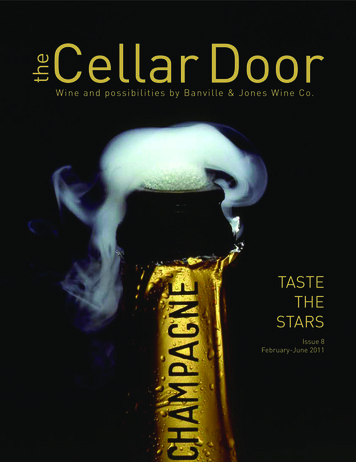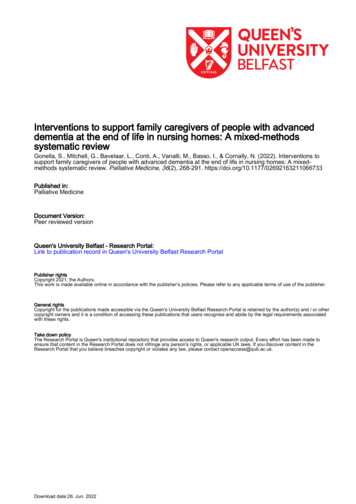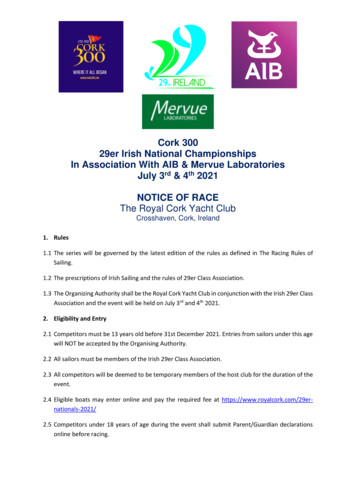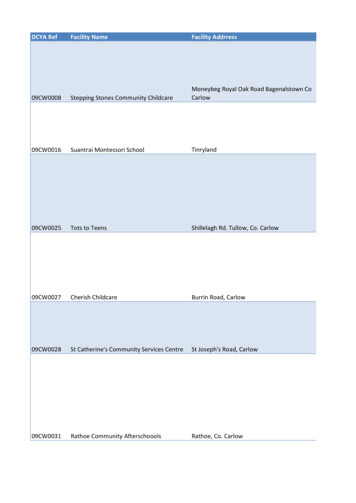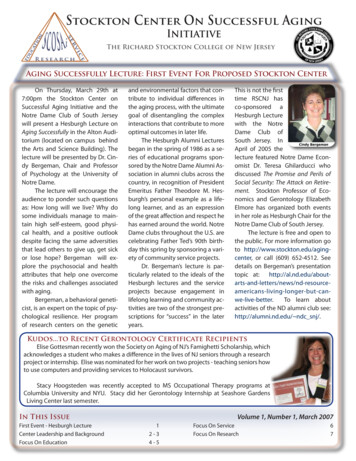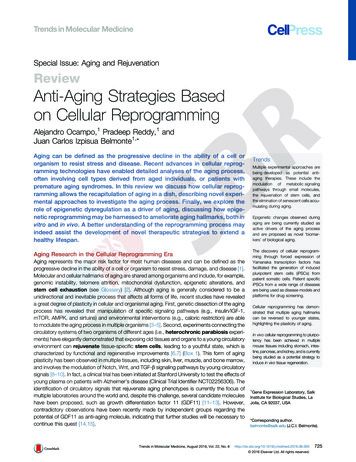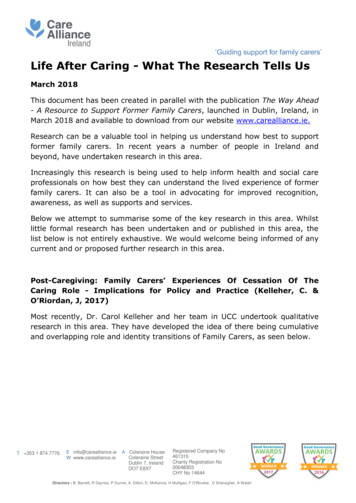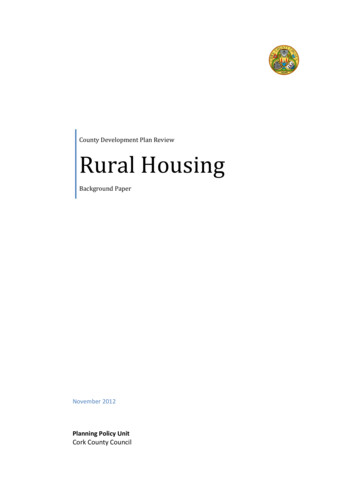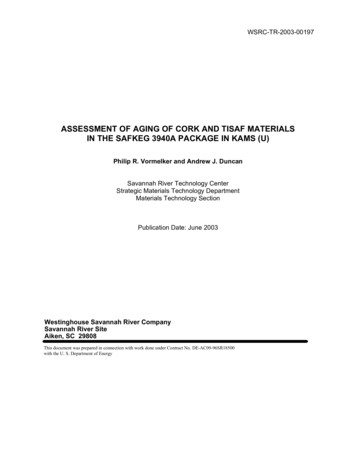
Transcription
WSRC-TR-2003-00197ASSESSMENT OF AGING OF CORK AND TISAF MATERIALSIN THE SAFKEG 3940A PACKAGE IN KAMS (U)Philip R. Vormelker and Andrew J. DuncanSavannah River Technology CenterStrategic Materials Technology DepartmentMaterials Technology SectionPublication Date: June 2003Westinghouse Savannah River CompanySavannah River SiteAiken, SC 29808This document was prepared in connection with work done under Contract No. DE-AC09-96SR18500with the U. S. Department of Energy
This document was prepared in conjunction with work accomplished under Contract No.DE-AC09-96SR18500 with the U. S. Department of Energy.DISCLAIMERThis report was prepared as an account of work sponsored by an agency of the United StatesGovernment. Neither the United States Government nor any agency thereof, nor any of theiremployees, makes any warranty, express or implied, or assumes any legal liability or responsibilityfor the accuracy, completeness, or usefulness of any information, apparatus, product or processdisclosed, or represents that its use would not infringe privately owned rights. Reference herein toany specific commercial product, process or service by trade name, trademark, manufacturer, orotherwise does not necessarily constitute or imply its endorsement, recommendation, or favoring bythe United States Government or any agency thereof. The views and opinions of authors expressedherein do not necessarily state or reflect those of the United States Government or any agencythereof.This report has been reproduced directly from the best available copy.Available for sale to the public, in paper, from: U.S. Department of Commerce, National TechnicalInformation Service, 5285 Port Royal Road, Springfield, VA 22161,phone: (800) 553-6847,fax: (703) 605-6900email: orders@ntis.fedworld.govonline ordering: http://www.ntis.gov/help/index.aspAvailable electronically at http://www.osti.gov/bridgeAvailable for a processing fee to U.S. Department of Energy and its contractors, in paper, from: U.S.Department of Energy, Office of Scientific and Technical Information, P.O. Box 62, Oak Ridge, TN37831-0062,phone: (865)576-8401,fax: (865)576-5728email: reports@adonis.osti.gov
WSRC-TR-2003-00197TABLE OF CONTENTS1.0PageSummary. 12.0Background and Materials Description . 13.0Mechanical Properties . 34.0Thermal Properties. 45.0Discussion. 46.0Conclusions and Recommendation. 57.0Quality Assurance . 58.0References. . 6
WSRC-TR-2003-00197Page ii of ivP. VormelkerMay 2003LIST OF FIGURESFigure 1. Overall Schematic of the SAFKEG 3940A Packaging Assembly . 7Figure 2. Exterior sections (top, middle, and bottom) of TISAF taken from a SAFKEGpackage. . 8Figure 3. Exterior sections (top, middle, and bottom) of TISAF taken from a SAFKEGpackage. . 9Figure 4. Outer surface of middle section of TISAF . 10Figure 5. Inner surface of bottom section of TISAF from Figure 3 . 11Figure 6. Photo of broken section of TISAF revealing wide range of cell sizes. . 11Figure 7. Circled areas in Image reveals porosity on the ridge formed by the outer keg. . 12Figure 8. In top TISAF section, near the top surface, porosity is visible. . 12Figure 9. Room Temperature Compression Test Data for Resin-Bonded Cork1). 13Figure 10. Room Temperature Compression Test Data for TISAF1). 13Figure 11. Room Temperature Tensile Test Data of Resin Bonded Cork. . 14Figure 12. Room Temperature Uni-axial Compression Data of Resin Bonded Cork. . 14Figure 13. Room Temperature Hydrostatic Compression Data for Resin Bonded Cork. 15Figure 14. Room Temperature Tensile Test Data of TISAF. . 15Figure 15. Room Temperature Test Data for TISAF in Compression, Tension and Tri-axialCompression. 16Figure 16. Room Temperature Compression Test of TISAF. . 16Figure 17. Selected Stress Strain Curves used for the Mohr’s Circle representation of FractureStress vs. Shear Stress for TISAF. . 17Figure 18. Mohr’s Circle representation of Fracture Stress vs. Shear Stress for TISAF. 17Figure 19. Weight loss from TGA Analysis of Resin Bonded Cork in Flowing Argon and Air. . 18Figure 20. Weight loss from TGA Analysis of TISAF in Flowing Argon. 18
P. VormelkerMay 2003WSRC-TR-2003-00197Page iii of ivLIST OF ABBREVIATIONSASTMAmerican Society for Testing and MaterialsASMEAmerican Society of Mechanical EngineersPCVPrimary Container VesselRFETSRocky Flats Environmental Technology SiteSARPSafety Analysis Report for PackagingSRSSavannah River SiteSRTCSavannah River Technology CenterSCVSecondary Container VesselSSStainless Steel
P.R. VormelkerMay, 20031.0WSRC-TR-2003-00197Page 1 of 18SUMMARYThis report provides an assessment of the potential for aging and degradation of the resinbonded cork and the Thermal-Insulating, Shock-Absorbing Foam (TISAF) materials that are1)components of the SAFKEG 3940A package . This package may be used for interim storageof plutonium materials in the Savannah River Site K-Area Materials Storage (KAMS). Thesematerials are important to the performance of the SAFKEG package in KAMS in several areasas follows: The mechanical properties of the cork and foam are inputs to the structural analyses ofthe SAFKEG 3940A package that include the KAMS design basis events. Mechanicaltesting (compression and tensile) of the cork and foam was performed to develop a setof baseline (non-aged condition) properties, supplementing the properties reported inthe Safety Analysis Report for the 3940A SAFKEG Package. These properties weredeveloped for input to structural analyses of the SAFKEG 3940A package under KAMSaccident events. The testing details and results are contained in this report. The composition and compatibility of the cork and foam materials with the othercomponents of the package under aging conditions are needed to establish andmaintain containment and handleability of the package. Various tests were performedto provide materials data to evaluate the potential for corrosion of the stainless steelouter containment vessel and the keg due to contact with cork and foam materials.Samples of cork and foam were examined to determine their potential to absorb andcontain water. Both the cork and foam readily absorb water due to their open cellstructures that could lead to conditions aggressive to the stainless steel materials. Inthe case of the TISAF, the pH of the water was lowered from approximately 7 toapproximately 2. High levels of chloride (approximately 5000 ppm) in the cork weremeasured by neutron activation. This level of chloride would cause pitting attack ofstainless steel if chloride was leached from the cork and sufficient water was present.This condition is not expected in KAMS. The physical properties of the cork and foam are inputs to the thermal analysis. Thephysical behavior under aging conditions is important to the potential off-gassing anddimensional changes. The properties reported in the Safety Analysis Report for the3940A SAFKEG Package were used in the thermal analyses of the SAFKEG in KAMS.Thermo-gravimetric analysis (TGA) was used to examine the possibilities of chemicaland density changes as a result of aging. Both materials (as-received condition)appeared to release water at the temperatures expected during storage conditions butwere otherwise stable.The conclusions support the use of the SAFKEG 3940A package for interim use for containmentin KAMS for a period of 10 years. The conclusions are predicated on the surveillance of thematerials to verify that degradation significant to the performance of the 3940A package toprovide containment is not occurring.2.0BACKGROUND AND MATERIALS DESCRIPTIONPlutonium-bearing materials (metal and oxides) currently stored at the Rocky FlatsEnvironmental Technology Site (RFETS) and at the Hanford Site (Richland - RL) are to be2)placed in 3013 storage containers . The 3013 containers from RFETS are being loaded in9975 shipping packages, and are planned to be shipped to SRS shortly. The 3013 containers1)from RL may be shipped to SRS in SAFKEG 3940A shipping packages (Figure 1). Theinterim storage facility for the packages at the Savannah River Site, K-Area Materials Storage
WSRC-TR-2003-00197(KAMS), is being readied to safely receive and store these packages for interim storage prior tofuture disposition. The SAFKEG 3940A shipping package design consists of a double skinnedstainless steel keg body (outer keg is 304 stainless steel (SS) with a 304L liner) with a boltedclosure lid and O-ring seal (Figure 1). The cavity between the keg and the liner is filled with alayer of phenolic foam, also known as TISAF (Thermal-Insulating, Shock-Absorbing Foam).This cavity is normally sealed but will vent through a bottom vent plug during a fire accidentcondition. Within the liner is a resin-bonded cork layer; two removable 304L stainless steelcontainment vessels, each sealed with a bolted lid and double O-rings as shown in Figure 1.The 3013 storage container is placed inside the inner containment vessel (ICV) that is insertedinto the outer containment vessel (OCV).The TISAF foam is used as an insulator and held in a sealed annular space between two layersof stainless steel in the SAFKEG 3940A. The TISAF material is manufactured by a proprietaryprocess and formulation and is based on a phenolic resin (chemical formula C7.4H7.8O) filled withan unknown amount of calcium sulfate semi-hydrate (plaster of paris) which subsequentlyhydrates to form calcium sulfate dihydrate, or gypsum (CaSO4·2H2O). The foam compositionincludes the following; 39.4% carbon, 31.9% oxygen, 13.8% calcium, 11% sulfur, and 3.8%hydrogen. There are also small amounts of phosphorus and no chlorides are in the foam. Thefoam is produced by reacting the phenolic resin and filler with paratoluene sulphonic acid (3%)3)and ortho-phosphoric acid (0.6%). All percentages are based on weight. The acid is stated tocompletely react in the foaming process. During the foaming process, the foam adheres to the4)stainless steel.In the 1970’s and 1980’s the roofing and chemical industries suffered bad publicity andreplacement costs due to extensive corrosion of roof decking and piping from moistureabsorption by foam insulation with subsequent acid and chloride release causing corrosion on5)-6)7)Specific corrosion problems with steel were noted with phenolic foam insulation.steel.Due to the historical problem with thermal insulation, tests were conducted on TISAF todetermine moisture effects and chloride content. A reduced size TISAF sample was immersed8)in water for 96 hours per ASTM D-2842. The single test result revealed 46% water absorption.The TISAF exhibited a constant release of bubbles. Because of the gypsum content and thecell nature of this foam, the high water absorption in the structure is thought to be the result ofinterconnecting paths between individual cells which allows air to be released as exhibited bythe bubbles.Samples of the TISAF from a SAFKEG package are shown in the photographs in Figures 2-8.Open cells (or porosity) are visible on both sides of the TISAF. TISAF has a wide distribution ofcell sizes, on the inside surface and the outside, as seen in Figures 4-8. A distribution in cellsizes was also observed from top to bottom and from surface to center thickness. This couldindicate anisotropy and properties may be different depending on parallel to or transverse to thepouring direction. The SAFKEG manufacturer states that the TISAF adheres to the stainlesssteel surfaces after curing.Initial testing of the TISAF revealed a significant pH reduction (from 7.0 to 2.2 after9)approximately 6 hours, and leveled out at 2.31 after 96 hours of water immersion . As long asthe seal is maintained, only minimal entrained moisture would be expected in the TISAF andthis would not be sufficient to cause a low pH leachate in the compartment containing theTISAF. Neutron activation analysis was used to measure the chloride level in the foam. The
P.R. VormelkerJune 2003WSRC-TR-2003-00197Page 3 of 19results showed the level is 49 /- 8 ppm. This level of chloride is typically not significant tocause pitting corrosion attack for materials in contact with stainless steel.Cork is a natural wood product produced in granular form. The cork in the SAFKEG 3940A ismixed with a synthetic resin binder. The mixture of the two is then compressed with heat toform the required shape. The synthetic resin is a polyurethane resin. A sealer is also used andit is a two-part compound based on urea formaldehyde with an alkyd plasticizer made by1)Rustins Ltd. coating. The outside surface of the cork is then sealed with an organic polymer.The resin and organic polymer should seal the cork. In addition, the cork is preserved in theSAFKEG with an O-ring on the keg to provide for weather protection. Hence, it is unlikely thatmoisture (other than any on the interior during loading) will ever be a corrosion problembetween the cork and the stainless steel liner and outer containment vessel. However, thestatement in the SAFKEG 2863 SARP states that the O-ring seal is only designed for weather10)protection and is not designed to be airtight.Since high humidity air infiltration in theSAFKEG 3940A lid is possible, and water immersion tests were not conducted prior to thepresent study, a preliminary immersion tests was conducted on the cork. Using the same testsmethods mentioned above for TISAF, the cork water immersion results revealed that 51% waterwas absorbed with a 19% increase in volume and the pH level ended up as 6.3. Both testswere carried out for 96 hours. Water absorption in a cork that has a resin binder should notoccur if sufficient resin was used to coat individual granules. This shows that if moisture were topenetrate into the cork from condensation (or high humidity levels), swelling would occur andcould hold moisture against the stainless steel. Chloride levels in the cork were determined tobe 4890 /- 65 ppm. This level of chloride would cause pitting of the stainless steel if thechloride was leached from the cork and sufficient water was present. This is a potential problemand is an important item to monitor as part of surveillance in storage.One potential problem in the long-term storage of the SAFKEG 3940A is the unknown behaviorof the TISAF and the cork at the temperature conditions in the package and how aging affectstheir insulation and impact absorbing properties. In general, there is little documentedinformation describing time- and temperature-induced changes in mechanical and physicalproperties for any foam or cork materials. One report will be described below.1)Aging properties of the TISF and cork are not provided in the SARP. Corrosion Assessmentand aging of stainless steel components used in the 3013 storage container are currently under11)Normal properties of materials that are affected by aging include physicalevaluation.properties such as tensile strength, compressive strength, impact strength, modulus,dimensions and weight changes. The TISAF is entirely contained within the annular spacebetween two stainless steel walls and access to air is expected to be minimal. The onlyavailable air is that contained within the closed cell walls of the foam during the insertionprocess. Moisture should not be a problem as long as the TISAF annular space is sealed. Theseal is maintained by the bottom seal plug in the SAFKEG 3940A design, Figure 1.3.0MECHANICAL PROPERTIESMechanical testing was performed to establish a set of baseline materials properties for thedetermination of the impact of aging and to serve as inputs for stress analyses of hypotheticalaccident scenarios. The tests complemented the data already available in the SARP andprovided a starting point by which the effects of aging can be determined. In the SARP theeffect of temperature on the relationship between stress and strain is well represented. Figures9 and 10 show how the stress vs. strain curve changes with temperature for resin bonded cork
WSRC-TR-2003-00197and TISAF, respectively. However, the effects of strain rate and loading conditions areavailable. To supplement the data available, tension, compression and multi-axial compressiontests were performed on both cork and TISAF at different strain rates. The tensile tests wereperformed in accordance with ASTM D1623. The compression testing was performed inaccordance to ASTM D1621. The testing assisted in performing an adequate simulation of themechanical response of SAFKEG materials during accident scenarios. These mechanicalproperties are reported in Figures 11 – 18.The stress vs. strain curves measured for resin bonded cork in tension, compression andhydrostatic compression are shown in Figures 11 – 13, respectively. The most notableobservation of the cork is that it exhibits viscoelastic behavior. Specifically, the deformation ofthe material has an elastic component and viscous component. When the stress is removed thematerial will recover to the original shape over a time interval. The SARP stated that thisrecovery was 98%. Load relation tests were conducted in compression and showed that andaverage 36% of the stress was relieved during a 30-sec hold before unloading. In addition, thecork also shows a positive strain rate sensitivity at room temperature. This behavior was alsoobserved in the hydrostatic compression tests, shown in Figure 13. Overall, the stress-strainproperties measured in this study did not significantly differ from properties listed in the SARP.The stress vs. strain curves measured for TISAF in tension and compression are shown inFigures 14 and 15, respectively. The foam is a mixture of gypsum and phenolic resin, whichexhibits a very large, and widely varying, cell size. From Figure 14, the brittle nature of thismaterial can be observed. The material exhibited very limited strain rate sensitivity. The tensilespecimens failed without any appreciable nonlinear elasticity. In compression, material behavesin a similar fashion. The initial potion of the curve is linear until failure. Subsequent deformationoccurs by successive loading and crushing events until complete “powdering” of the material. InFigure 16, a picture of a compression specimen after a compression test illustrates its brittlebehavior. The behavior is significantly different to the properties exhibited in the SARP (Figure10).In order to determine the effect of stress state on deformation stress, the sample wascompressed in a tri-axial compression fixture which was able to preload samples to constantloads in 2 orthogonal directions (σ1 and σ2) and measure breaking strength in the third (σ3).Plotting σ1 and σ3 together enables the determination of the yield surface using Mohr’s circle.In Figure 17 the three curves that bound all other tensile or compression data are shown. Whenthese curves are plotted using Mohr’s circle a tangent line can be used to estimate the breakingstrength at different loading conditions. In Figure 18, the σ1 and σ3 values of stress are plottedas intersection points to the X-axis. A circle is used to plot the relationship between X and Y. Inthis figure, a least squares fit of the tangent points was produced and the equation for the line isshown. Since the material is so brittle and the stress-state is compressive, the tensile curvewas neglected and a yield surface was estimated with the two compression tests. This datawas used as input to the stuructrual impact analysis of the SAFKEG in KAMS under accidentconditions.4.0 THERMAL PROPERTIESThermo-gravimetric analysis was used to measure indicate whether aging at elevatedtemperatures would lead to a change in properties during interim storage. The SARP statesthat the cork and TISAF are unaffected during aging at temperature up to 180 C and 140 C,respectively. A weight loss of approximately 7% was noted for both materials (attributed todrying of entrained water). Figures 19 and 20 are weight loss vs. temperature plots of cork and
P.R. VormelkerJune 2003WSRC-TR-2003-00197Page 5 of 19TISAF, respectively. Initially, a small amount of weight loss (presumably from absorbed water)appears to occur during hold and heating up to 140 C. Samples of cork and foam have beenobserved to lose up to 6.5 and 3.5 wt. %, respectively, upon heating to 248 F (120 C). So theweight loss, previously reported in the SARP, is representative of the samples tested in thepresent study. After this initial adjustment, the weight stabilizes until 572 F (300 C) for cork and752 F (400 C) for TISAF. Above these respective temperatures, the majority of the sample isconsumed. In the case of the cork, 100% of the sample (80% flowing argon in air) is consumedbefore 932 F (500 C) is reached. In the case of TISAF, 55% of the weight is consumed before1022 F (550 C). Beyond this temperature, the sample weight remains relatively constant up to1472 F (800 C).5.0DISCUSSIONAmbient temperature mechanical properties of the TISAF and cork have been established.Tensile and compression data are shown in Table 1. The calculated temperatures (Table 2)during storage for these materials reach a maximum of 232 F (111 C) for the cork and 146 F(63 C) for TISAF.12) These temperatures are high enough to cause depletion in water or loss ofvolatile organic compounds. This could have an impact of mechanical and physical properties.The long term effects of temperature will be established during the surveillance program inKAMS, which should include sampling of the TISAF and cork and performing tests to determinephysical and mechanical properties and examination for moisture effects. The development ofspecific surveillance activities for these materials is beyond the scope of this report.A study has already been initiated by Sandia to determine thermal aging effects on mechanicalproperties of polyurethane foam used in multiple weapons systems.13) In this case, the foamsare used for volume fillers, electrical isolation and shock and vibration absorbers. The specifiedfoam for the Sandia testing is BKC44402 (available from Honeywell Federal Manufacturing andTechnologies). The density of this foam is 0.1 g/cm3, which is slightly less than the TISAF (0.4g/cm3). The Honeywell foam does not contain a filler material while the TISAF uses gypsum.The aging time intervals for this study are 1 week, 3 months, 7 months, 1 year and every yearthereafter until the final 4 year period is reached. Aging data after 1 year at ambienttemperature, 60 C and 80 C are summarized as follows: Impact tests for specimens aged at 60 C and 80 C revealed a drop in energyabsorption after 7 months of aging. Specimens aged at ambient temperature showed signs of decreased energyabsorption after 1 year. Spallation was observed while foam is compressed during the impact test Conventional tensile and compression behavior was unaffected through 1 year ofaging at temperatures up to 80 C. Initial mass increase after exposure to room temperature, most likely due to moistureabsorption. Mass losses (less than 1.7%) after exposure to 60 C and 80 C for 1 year, suggestedto be result of moisture and surfactant losses.Another study on natural cork showed that the viscoelastic behavior of cork changed above140 F (60 C). 14) Specifically, increases in the storage modulus and decreases in the relaxationprocesses were observed during heating or aging at or above this temperature. This diminishesthe damping capabilities of cork.
WSRC-TR-2003-00197It is not known whether TISAF will perform in a similar fashion to the polyurethane foam fromthe SANDIA study. Diminished damping capacity of cork would adversely impact itsperformance in structural analyses.6.0CONCLUSION AND RECOMMENDATIONSThe results of the evaluation of the aging assessment of the resin-bonded cork and the TISAFmaterials of the SAFKEG 3940A package support its use for interim storage in KAMS for aperiod of 10 years, while maintaining full containment and handleability of the package,. Theresults were based on limited baseline and aging data. This conclusion is predicated on thesurveillance of the materials to verify that degradation, significant to the performance of the3940A package to provide containment and handleability, is not occurring.7.0QUALITY ASSURANCEThe preparation of this technical work and its documentation were performed as specified in theWSRC E7 Manual, procedure 3.60. Laboratory notebooks for the materials testing weremaintained in accordance with SRTC Procedure L1, 7.16, Rev. 2. Internal technical review ofthis report is governed by the WSRC E7 Manual, procedure 2.40.8.0REFERENCES1)LAUR-01-2081, Rev. 1 Draft, Safety Analysis Report for SAFKEG 3940A, Los AlamosNational Laboratory, September 27, 2002.2)DOE Standard, DOE-STD-3013-2000, Stabilization, Packaging, and Storage ofPlutonium-Bearing Materials, U.S. Department of Energy, September 2000.3)R. A. Vaughan, CTR 2001/12 Issue C, Summary of Physical Properties andCompositions of TISAF, September 27, 2002 in LAUR-01-2081, Rev. 1 Draft, SafetyAnalysis Report for SAFKEG 3940A, Los Alamos National Laboratory, September 27,2002).4)R. A. Vaughan, E-mail to P. R. Vormelker, Subject: TISAF in SAFKEG 394-A, April 8,2003.5)W. G. Ashbaugh, “Corrosion Under Thermal Insulation,” Metals HandbookEdition Volume 13 Corrosion, ASM International (1987), pp. 1144-1147.6)D. M. Street, R. F. Smith, T. Fitzsimmons, and D. Willoughby, A Total EngineeringApproach to the Problem of Corrosion of Steel Insulation, Symposium ProceedingsCorrosion Under Wet Thermal Insulation: New Techniques for Solving Old Problems,National Association for Corrosion Engineers, 1990.7)T. L. Smith, J. D. Carlson, and T. L. Walzak, Steel Deck Corrosion Associated withPhenolic Roof Insulation: Problem Causes, Prevention, Damage Assessment andCorrective Action, Proceedings of the 10th Conference on Roofing Technology,Gaithersburg, Md, National Roofing Contractors Association, April 22-23, 1993. Ninth
P.R. VormelkerJune 2003WSRC-TR-2003-00197Page 7 of 198)ASTM D 2842, Standard Test Method for Water Absorption of Rigid Cellular Plastics,ASTM International (2001).9)P. R. Vormelker, WSRC-TR-2003-0195, Internal/External Corrosion Analysis of theSAFKEG 3940A Package in KAMS, Westinghouse Savannah River Company, May2003.10)LA-UR-93-4509, SAFKEG-SARP-01, Rev. 1, Safety Analysis Report for Packagings forSAFKEG 2863B, Los Alamos National Laboratory, June 1992.11)D. G. Kolman, LA-UR-98-5762 Revision 1, An Assessment of the Corrosion, StressCorrosion, Cracking, and Embrittlement of 3013 Storage Containers, Los AlamosNational Laboratory, 1999.12)N. K. Gupta, "Thermal Analysis of the SAFKEG Package for KAMS Project,” CalculationM-CLC-K-006600 (U), Westinghouse Savannah River Company, May 27,2003.13)S. H. Goods and L. L. Whinnery, SAND2000-8245, The Effect of Thermal Aging on theMechanical Properties of a Stockpile Polyurethane Foam, Sandia National Laboratories,June 2000.14)J. F. Mano, “The viscoelastic properties of cork,” Journal of Materials Science, Vol. 37,pp. 257-263 (2002)
WSRC-TR-2003-00197LinerOCV (outer containmentvessel)ICV (inner containmentvessel)TISAF FoamCorkKegFigure 1. SAFKEG 3940A shipping package showing location of the keg, TISAF foam, cork,outer containment vessel (OCV), and the inner containment vessel (ICV). The 3013 vessels willbe inserted into the ICV of the SAFKEG. The SAKEG is approximately 40 inches high.
P.R. VormelkerJune 2003WSRC-TR-2003-00197Page 9 of 19TopMiddleBottomDigital ImageFigure 2. Exterior sections (top, middle, and bottom) of TISAF taken from aSAFKEG package. Surface is rough in a few places in the bottom section. Thethickness is slightly more than 1 ¾ inches. Note there is no surface coating on theTISAF. This is probably not typical of the SAFKEG 3940A package.
WSRC-TR-2003-00197TopMiddleDigital ImageFigure 3. Exterior sections (top, middle, and bottom) of TISAF taken from aSAFKEG package. Surface is rough in a few places. Note there is no surfacecoating on the TISAF. This may not be typical of the SAFKEG 3940A package.
P.R. VormelkerJune 2003WSRC-TR-2003-00197Page 11 of 19Digital ImageFigure 4. Outer surface of middle section of TISAF revealing surface problems inmiddle. The arrow, to the left, shows the location of the parting line between the twoseparate pours of the foam during filler of the cavity.
WSRC-TR-2003-00197Digital ImageFigure 5. Inner surface of
3940A SAFKEG Package were used in the thermal analyses of the SAFKEG in KAMS. Thermo-gravimetric analysis (TGA) was used to examine the possibilities of chemical and density changes as a result of aging. Both materials (as-received condition) appeared to release water at the temperatures expected during storage conditions but were otherwise stable.
